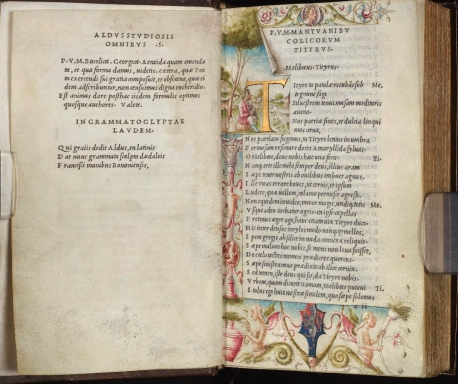
The John Rylands Library copy of the Aldine Virgil, printed on vellum, and illuminated with the coat of arms of the Pisani family of Venice. In the poem on the left page facing Virgil’s text Aldus praised the skill of the punchcutter Francesco Griffo of Bologna who designed the new Italic type. This type, based o the Italian humanist cursive script or Cancellersesca originally developed in the 1420s by the humanist and Niccolò de’ Niccoli, became the model for later Italic types
In April 1501 Venetian scholar printer Aldus Manutius issued an edition of the poems of Virgil (Vergil) in Italic typeOffsite Link designed by the punchcutter Francesco GriffoOffsite Link, also known as Francesco da Bologna. A very skilled craftsman, Griffo was also a “tumultuous character” who ended his life in the hangman’s noose for murdering his son-in-law. This was the first book completely printed in Italic typeOffsite Link, an adaptation of humanist script, possibly Aldus’s own handwriting. Facing the first page of Virgil’s text, Aldus included a poem praising the skill of Griffo who designed the new type. In addition to its elegant design, Italic type had the advantage of a higher character count, allowing more information to be printed legibly in less space than Roman or Gothic type.
Aldus’s edition of Virgil was also the first of a series of volumes that he issued in the pocket, or octavo format. This smaller format had previously been used for editions of devotional texts, but Aldus was the first to use the smaller format to make non-devotional literature available in the more portable format, and at lower cost. Davies pointed out that a signifcant reason for Aldus’s introduction of the octavo format was the collapse of the credit market in Venice in 1500 caused by “Venetian defeats and Turkish advances,” which caused many business failures, and would have motivated Aldus to publish books that could be sold at lower cost.